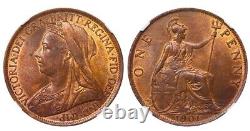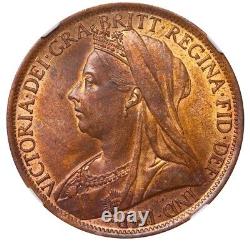1901 Great Britain Queen Victoria Bronze 1 Penny NGC MS 63 BN






1901 Great Britain Queen Victoria Bronze 1 Penny NGC MS 63 BN. Victoria (Alexandrina Victoria; 24 May 1819 - 22 January 1901) was Queen of the United Kingdom of Great Britain and Ireland from 20 June 1837 until her death in 1901. Her reign of 63 years and 216 days-which was longer than those of any of her predecessors-constituted the Victorian era. It was a period of industrial, political, scientific, and military change within the United Kingdom, and was marked by a great expansion of the British Empire. In 1876, the British Parliament voted to grant her the additional title of Empress of India.
Victoria was the daughter of Prince Edward, Duke of Kent and Strathearn (the fourth son of King George III), and Princess Victoria of Saxe-Coburg-Saalfeld. After the deaths of her father and grandfather in 1820, she was raised under close supervision by her mother and her comptroller, John Conroy. She inherited the throne aged 18 after her father's three elder brothers died without surviving legitimate issue. Victoria, a constitutional monarch, attempted privately to influence government policy and ministerial appointments; publicly, she became a national icon who was identified with strict standards of personal morality. The 1901 Great Britain Bronze One Penny is a significant coin, marking the end of Queen Victoria's long reign. This coin features a portrait of Victoria facing left, designed by Sir Edward Poynter, which was the last portrait of her used on British coinage. The reverse depicts Britannia seated, a common emblem on British coins of the era, symbolizing strength and stability. The 1901 Penny is particularly notable because it was issued in the year of Queen Victoria's death, making it a poignant piece of history. It captures the transition from the 19th century to the 20th, reflecting both the continuity and change of an era in British numismatics.

